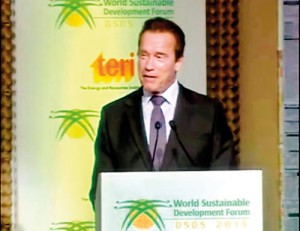Schwarzenegger: From Terminator 5 to ‘green’ champion
In his most recent reincarnation, Arnold Schwarzenegger is a green hero. The former governor of California was in India last week to attend the 15th Delhi Sustainable Development Summit (DSDS), where he praised the Indian government for embracing the “solar revolution” and putting India on the path to increasing its solar energy capacity to 100 gigawatts by 2022.

New role: Arnold Schwarzenegger addressing the Delhi summit
Schwarzenegger went on to applaud the “real action heroes” around him, beginning with Rajendra K. Pachauri, chairman of the Intergovernmental Panel on Climate Change (IPCC) and director of The Energy Research Institute (TERI) which organises the summit. The 67-year-old looked every bit ‘the governator’ – a title he earned over his two terms as the head of California (2003-2011). His speech at the summit delivered a quote a minute, as he dwelled on what the sunshine state had accomplished both during his tenure and after – though he couldn’t resist the urge to slip in a plug for his upcoming film.
“It’s also great to be here because I have this ability of stepping in from the fantasy world to the real world. Fantasy world because I just finished Terminator 5, where we jumped the round and we had the shoot-outs and explosions and drama, and special effects,” he said.
Terminator Genisys which is due for release this July, is supposed to “reset” the series, ‘acting as a sequel, prequel, and reboot to the series’.The film will be the first in a new trilogy with sequels due in 2017 and 2018. It will pave the way for a new timeline in John Connor’s universe, one in which the character Sarah Connor encounters the Terminator T-800 played by Schwarzenegger much earlier – so early in fact that he raises her from the age of nine. She even calls him “Pops.” Fans will savour a script that allows Schwarzenegger to re-deliver what is perhaps his most iconic line, half-threat and half-promise: “I’ll be back.”
Schwarzenegger is interesting for the eccentric blend of public personas he displays. A wrestling fan he made headlines earlier this year when he was inducted into the ‘celebrity wing’ of the WWE Hall of Fame. The scandals that have plagued his personal life and led to the breakup of his 25-year marriage continue to be of interest to journalists but when he declares, “Today, “I’m here to talk about the real world,” it’s very much in the role as a champion of the environment.
Schwarzenegger has been praised for his part in putting California at the forefront of America’s response to climate change. The state has made a dramatic push to develop renewable energies, invest in innovative new green technologies and create essential infrastructure. During his tenure Schwarzenegger signed two notable bills – one was the nation’s first cap on greenhouse gas emissions and a second that ensured that large utilities and corporations in California could only sign long-term contracts with suppliers who met the state’s greenhouse gas emission standards. Together, they were part of a drive to significantly reduce California’s emissions.
Since leaving office Schwarzenegger has continued to push his pro-environment agenda through the non-profit R20: Regions of Climate Action and the USC Schwarzenegger Institute for State and Global Policy.
Speaking at DSDS he said, “This year alone we will dump 40 billion tonnes of greenhouse gases into the atmosphere,” going on to outline the high toll on human life that extreme weather events and pollution had taken. “The latest United Nations report predicts that further warming will slow down economic growth, increase poverty and further erode food security around the world, trigger mass migration and increase susceptibility to infectious diseases.” With that in mind, he called for sub-national governments to begin thinking differently – and independently – from national leaders.
California, he said, did just that, going against naysayers who predicted the economy would crash if pro-environment policies were adopted. Instead California’s ‘green economy’ has since outpaced national growth. “We know in California that we don’t have to choose between the environment and the economy. We know the opposite is true,”Schwarzenegger said.
In one of the more rousing moments of his speech, he went on to declare, “This is bigger than any movie, this is the challenge of our time and this is why I am on a crusade to reverse this trend, and to create a sustainable energy future, and to terminate climate change once and for all.”
Unfortunately, it will take more than inspirational words to engineer a much needed global agreement on climate change mitigation. As more than one speaker noted, 2015 is a crucial year for international development with the International Conference on Financing for Development (FfD) in July, the UN summit on Sustainable Development Goals (SDGs) coming up in September and the prospect of a new global climate agreement at United Nations Climate Change Conference in December.
Speaking at the event, Laurent Fabius, France’s Minister of Foreign Affairs and International Development emphasised the need for a “universal and differentiated agreement” which would achieve the common objective of limiting global warming to below 2°C.
The last is the figure negotiators in Copenhagen in 2009 agreed to, because an Earth hotter than that was considered unacceptably dangerous. (We’ve seen a 0.85°C increase since 1880, the rise associated with increased risk of severe storms and lethal heat waves.) Now amid scepticism that this can be accomplished, countries are hoping that the COP 21 negotiations in Paris will inspire long-term changes in the way we address global warming.


